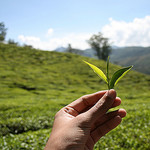We recently attended a tasting session featuring teas from around the world. The teas were outstanding to be sure, however, they represented teas from only a small portion of the world. The countries represented included China, Japan, Tibet, India, Sri Lanka, and Kenya and provided a very diverse set of teas. These included white, yellow, green, black, dark, and even purple teas. But our tasting from “around the world” barely even scratched the surface. There are a huge number of countries growing teas. In fact, more than 50 countries grow tea today including many from Asia, a good number from Africa, and some perhaps surprising locations like former Russian states, Iran, Argentina, Brazil, and yes, even the United States, though not always at a high enough to be globally competitive. While the top four growers (China, India, Sri Lanka, and Kenya) far and away surpass the others, tea production is very much a global business. The average American consumer tea is most likely from China, India, Sri Lanka, or Kenya. However, to illustrate just how global the business is, a somewhat dated report by the U.S. Department of Labor noted in 1996 that Germany, which grows virtually no tea, has consistently been one of the top countries supplying tea to the US market (Department of Labor, n.d.)!

Countries grouped by relative global share of tea production. Based on 2011 United Nations Food and Agriculture Organization data. http://www.fao.org/statistics.en/ (Full Tableau Visualization)
Tea as a Global Commodity
Tea is the second most consumed drink in the world, behind water, and demand continues to grow year after year. While tea is consumed in the form of loose leaf, bagged tea, and chai, innovations in ready to drink teas, and powdered tea drinks in Asia continue to drive additional growth. One of the fastest growing segments in Asia, according to Euromonitor (Friend, 2013), is the powered tea segment with products like Xiang Piao Piao, which is a single serve cup of instant powered tea in a variety of sweetened flavors. According to the UN’s Intergovernmental Group on Tea, demand for black tea has exceeded supply since 2009. This long term demand is expected to keep the price of tea high for years to come (United Nations, 2012).
Where demand exceeds supply the price generally stays high until supply rises enough to meet that demand so it is reasonable to expect that more countries will see commercial tea planned and those already in the business may increase both the land area under cultivation and work to improve the yield of existing plantations. Additionally, some coffee plantations may choose to change over to tea. This is because coffee rust is increasingly impacting coffee plantations in South America and pushing down coffee production rates. Rust isn’t actually new, it’s what drove Sri Lanka to switch from growing coffee to tea back in the mid to late 1800’s. However, it is now impacting South America, parts of which are seeing the worst outbreaks of coffee rust since it took hold in the 1970’s. The U.S. Department of Agriculture is expecting significant decline in crop yields for the 2013-14 season on top of already significant declines in 2012-13 (U.S. Departement of State, n.d.)
Given the growing appreciation and demand for ready-to-drink products and specialty teas in the United States, Canada, and other parts of the world we may very well have increased opportunity to experience an even wider variety of tea products from a wide variety of countries in the years to come.
[ See Related Post: Tea vs Coffee Imports – Who are the superpowers? ]
Works Cited
Department of Labor. (n.d.). ILAB – TEA. Retrieved from Bureau of International Labor Affairs: http://www.dol.gov/ilab/media/reports/iclp/sweat4/tea.htm
Friend, J. F. (2013). Global Tea Opportunities in Retail and Foodservice. World Tea East. Atlanta: Euromonitor.
U.S. Departement of State. (n.d.). Retrieved from Coffee Rust Outbreak in Central America, Southern Mexico, and the Caribbean: http://www.state.gov/e/eb/tpp/abt/coffee/index.htm
United Nations. (2012, February 29). UN News Centre. Retrieved from Global tea prices set to stay strong this year, says UN agency: http://www.un.org/apps/news/story.asp/story.asp?NewsID=41411&Cr=Food+Prices&Cr1=#.UoS9i94o601




